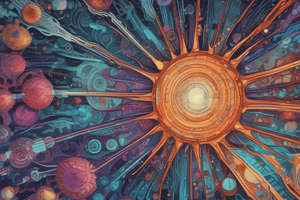Podcast
Questions and Answers
What is the function of the revolving nosepiece?
What is the function of the revolving nosepiece?
- To hold and rotate the objective lenses (correct)
- To move the stage up and down
- To control the amount of light passing through the condenser
- To adjust the intensity of the light source
Which part of the microscope is used for moving the stage up and down in small increments?
Which part of the microscope is used for moving the stage up and down in small increments?
- Fine adjustment knob (correct)
- Coarse adjustment knob
- Mechanical stage knobs
- Light intensity lever
Which microscope part concentrates light onto the specimen?
Which microscope part concentrates light onto the specimen?
- Condenser (correct)
- Objectives
- Ocular
- Scanning objective
What is the primary role of the iris diaphragm and lever?
What is the primary role of the iris diaphragm and lever?
What is the platform where the slide is placed called?
What is the platform where the slide is placed called?
Which part of the microscope adjusts the intensity of the light source?
Which part of the microscope adjusts the intensity of the light source?
Which part of the microscope do you look through to see the specimen?
Which part of the microscope do you look through to see the specimen?
Which component supports the microscope and houses the light source?
Which component supports the microscope and houses the light source?
Study Notes
Resolution and Microscope Quality
- Resolution refers to the capacity to deliver a clear image in fine detail, which is a measure of lens quality.
- Good resolution is essential to see small images clearly and distinguish one point from another nearby.
Components of the Microscope
- The microscope has various parts, including:
- Ocular (eyepiece of the microscope)
- Revolving nosepiece (holds and rotates objective lenses)
- Objectives (lenses with different magnification power)
- Stage (platform where the slide is placed)
- Iris diaphragm and lever (control the amount of light passing through the condenser)
- Condenser (concentrates light onto the specimen on the stage)
- Light (light source of the microscope)
- ON/OFF switch (switch used to turn light on/off)
- Arm (curved portion connecting the base and head)
- Coarse adjustment knob (moves stage up and down in large increments)
- Fine adjustment knob (moves stage up and down in small increments)
- Mechanical stage knobs (move stage left and right or forward and backward)
- Light intensity lever (adjusts intensity of the light source)
- Base (supports the microscope and houses the light source)
Instructions for Using the Microscope
- Follow instructor's directions to take a microscope to the workstation.
- Refer to Figure 2-1 and Table 2-1 to familiarize yourself with microscope parts and their functions.
Studying That Suits You
Use AI to generate personalized quizzes and flashcards to suit your learning preferences.
Description
This quiz covers the concept of resolution in microscopy, its importance, and the components of a microscope. It also includes instructions on how to familiarize oneself with the parts of a microscope.





